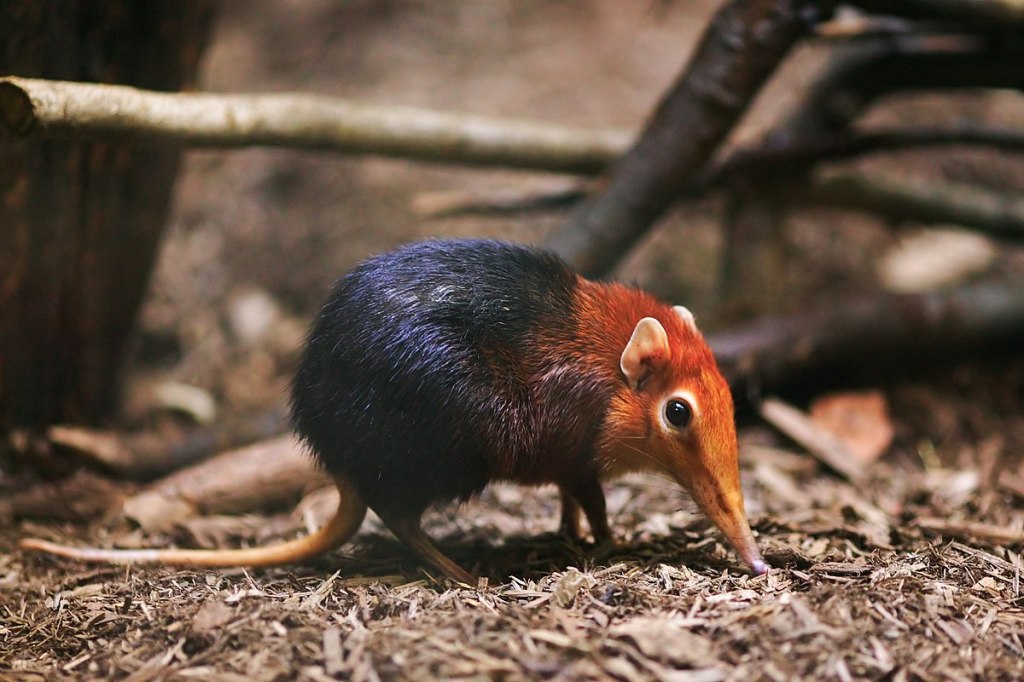
Named by: Peters, 1847
Taxonomy: Synapsida, Sphenacomorpha, Sphenacodontia, Sphenacodontoidea, Therapsida, Theriodontia, Cynodontia, Probainognathia, Mammaliamorpha, Mammaliaformes, Mammalia, Theria, Eutheria, Placentalia, Afrotheria, Afroinsectiphilia, Macroscelidea, Macroscelididae
Included species: R. cirnei (type), R. chrysopygus, R. petersi, R. udzungwensis
Sengis are great. They are commonly known as “elephant shrews”, and it’s not hard to see why. Like shrews, they are small, mostly insectivorous mammals, and, like elephants, they have an elongated, mobile snout. However, prior to the rise of phylogenetic analysis incorporating molecular data, perhaps no one would have guessed that they are, in fact, more closely related to elephants than to shrews!
In terms of their size, the most elephantine sengis are members of the genus Rhynchocyon, hence their vernacular name of “giant sengis”. By “giant”, we mean up to 750 g (1.7 lb), slightly larger than a gray squirrel. These gargantuan sizes are attained by the most recently discovered species, R. udzungwensis, which was only scientifically described in 2008. Other species range between 300-700 g (0.7-1.5 lb).
Rhynchocyon live in the forests of Africa. They uncover invertebrates hiding under leaf litter by using their snout and long claws, and, like other sengis, capture prey with their tongue. Unusually among sengis, they don’t clear trails to use as runways within their home range. At night, they sleep in nests made from leaves on the forest floor. These nests lack a proper entrance; instead, the sengis enter simply by digging into them from one side. Unlike other sengis, which have highly precocial young that can run shortly after birth, juvenile Rhynchocyon stay in a nest for several weeks before they are old enough to forage.
Being active during the day, Rhynchocyon must remain on the lookout for a variety of predators, including birds of prey and chimpanzees. Sengis are highly specialized for rapid, almost antelope-like quadrupedal bounding, allowing them to escape from danger (at least much of the time). Rhynchocyon have been recorded reaching speeds of 27 km/h (17 mph). If a predator is detected before it gets close enough to be an immediate threat, R. chrysopygus are known to slap their tail against the ground while walking away, perhaps signalling to the predator that it has been spotted. R. chrysopygus are additionally notable for the golden patch of hair on their rump, which may divert predator attacks towards the thickened skin in this region and increase the sengis’ chances of escape. The rump shield also protects R. chrysopygus against bites from rivals.
Typical of most sengis, Rhynchocyon are socially monogamous, probably mating for life. Within their shared territory, each member of a mated pair drives off rivals of the same sex. However, mates don’t spend much time with each other and don’t even share the same nest at night. The adaptive function of monogamy in sengis is debated, because male sengis contribute little, if any, parental care of the young. In Rhynchocyon, it appears that the primary selective pressure for monogamy may be the high energetic cost that would be required for a male to defend multiple females from his competitors. Indeed, male Rhynchocyon will enter temporary polygynous relationships if the opportunity arises, usually when a female in a neighboring territory loses her mate.
References
- Gibbon, C.D.F. 1997. The adaptive significance of monogamy in the golden-reumped elephant-shrew. Journal of Zoology 242: 167-177. doi: 10.1111/j.1469-7998.1997.tb02937.x
- Kingdon, J., D. Happold, M. Hoffmann, T. Butynski, M. Happold, and J. Kalina (eds.). 2013. Mammals of Africa Volume I: Introductory Chapters and Afrotheria. A&C Black Publishers Ltd., London. 352 pp.
- Rathbun, G.B. 2009. Why is there discordant diversity in sengi (Mammalia: Afrotheria: Macroscelidea) taxonomy and ecology? African Journal of Ecology 47: 1-13. doi: 10.1111/j.1365-2028.2009.01102.x
- Rovero, F., G.B. Rathbun, A. Perkin, T. Jones, D.O. Ribble, C. Leonard, R.R. Mwakisoma, and N. Doggart. 2008. A new species of giant sengi or elephant-shrew (genus Rhynchocyon) highlights the exceptional biodiversity of the Udzungwa Mountains of Tanzania. Journal of Zoology 274: 126-133. doi: 10.1111/j.1469-7998.2007.00363.x
—Albertonykus